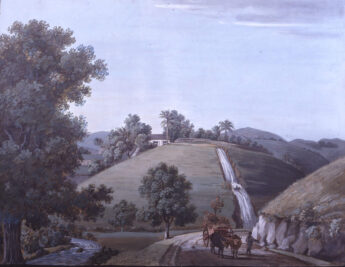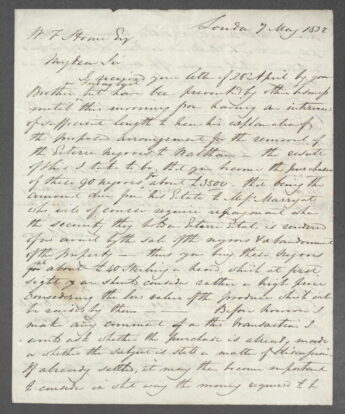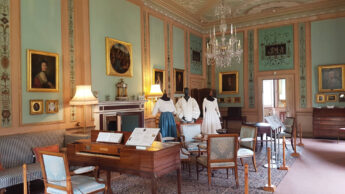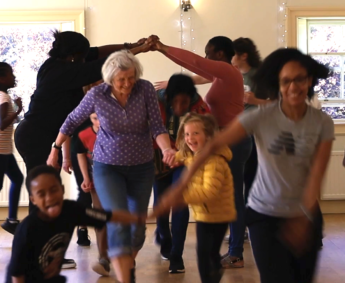Black History Month 2022

This year, 2022, has been an exciting time for everyone at Paxton House. We have been involved in a project which has revealed so much more about the history of Paxton and the Home Family’s estates in the Caribbean.
Paxton House was built from 1758 with an inherited land-based fortune from Scotland, but the house was finished and decorated from 1773, largely with income from estates in the West Indies owned by Ninian Home. These were estates producing sugar, cotton, coffee, and cocoa for the European market using enslaved African labour.
 We knew that Ninian Home owned two plantations in Grenada, in fact, we have an extraordinary set of watercolours that show details of life on Paraclete plantation. What we didn’t know, was the extent of Ninian’s Caribbean landholdings, details of the way of life of the enslaved people who worked for him and the impact of slavery both upon these people and others, as well as on Paxton House.
We knew that Ninian Home owned two plantations in Grenada, in fact, we have an extraordinary set of watercolours that show details of life on Paraclete plantation. What we didn’t know, was the extent of Ninian’s Caribbean landholdings, details of the way of life of the enslaved people who worked for him and the impact of slavery both upon these people and others, as well as on Paxton House.
We have worked in partnership with Descendants, an African and Caribbean cultural group for children and their families, to use our new understanding for a whole series of projects. Some were temporary, like our Caribbean Celebrations Day in June when local children and children from Descendants met for a day of dance, music, and fun, after months of studying the history of transatlantic slavery. Our major exhibition Parallel Lives, Worlds Apart which continues in 2023, uses replica and original 18th century costume to explore the different existences of the Home family and some of the enslaved people who worked for them. Some of our projects are permanent. We have a new permanent exhibition Caribbean Connections, Paxton House, and Slavery in the Morning Room and a Sugar & Slavery in house and online trail which together explore the history of the Home family’s involvement in the sugar trade, the lives of the enslaved people on their plantations and the works of art and furniture that were bought with the profits from slavery.
Here are some of the things we didn’t know. We’ve unearthed more details of Ninian Home’s life and death in Grenada. We have discovered details of his business and his interests in plantations in Grenada and Mustique. We’ve seen that Ninian sold his estate at Jardinefield, Berwickshire, to raise money towards the purchase of Paxton House (the rest came from a loan) from his uncle in 1773 and how his heir, his brother George Home, struggled with the enormous debts Ninian left behind. We’ve gained an insight into Ninian’s determination to gain a lucrative Government appointment that culminated with a trip to England and his appointment as Lieutenant-Governor in 1792; quite a promotion for a man who had left Scotland to seek his fortune at 17 and one which led directly to his death in Fédon’s Uprising three years later.
We have gained insights into the way of life of the enslaved population on Waltham plantation in Grenada. We know exactly how many people members of the Home family ‘owned’ at different times. We’ve explored what people ate, what they wore, how they worked, and how the Home family’s attitudes to them affected their lives.

The letters in the archives have introduced us to named individuals amongst the enslaved people at Waltham estate, like Fido, ‘much wore out’ after a long life of service as a skilled carpenter, who was rewarded with double food and clothing rations and sent a greatcoat by George Home. Others whom we now know a little more about include Veronique, who, at 100, was a great-great grandmother who lived at Waltham from at least 1771 to 1815; Gill, a trusted slave driver; Phillis, a promising ‘breeder’ who died following childbirth aged 19, and Kate, nanny to Nancy Stephens, George Home’s ward, who was freed in 1802 and sent a shawl as a present in 1812.

We’ve found evidence of people of African Caribbean origin actually present at Paxton House in the late 18thcentury. Frederick and Martine were personal servants to Ninian Home and his wife Penelope and accompanied them back to Scotland in 1788. Ottobah Cugoano was a servant to Alexander Campbell, a close friend and business partner of Ninian Home. When Alexander Campbell visited Paxton, Ottobah Cugoano almost certainly accompanied him, before gaining his freedom, settling in Britain and becoming an influential member of the Sons of Africa, working for the abolition of slavery.
 The exchange of goods and people between Paxton and the Caribbean have brought those distant islands and the people who lived there much closer. The links we have forged with children of Grenadian, African, Caribbean and Scottish heritage living in Britain today has made the history of Paxton House central to a new audience. What’s more, the whole project under the umbrella title of Parallel Lives, Worlds Apart has been shortlisted for a national Museums Change Lives – Reimagining the Museum Award from the Museums Association. The winners will be announced on 3 November 2022.
The exchange of goods and people between Paxton and the Caribbean have brought those distant islands and the people who lived there much closer. The links we have forged with children of Grenadian, African, Caribbean and Scottish heritage living in Britain today has made the history of Paxton House central to a new audience. What’s more, the whole project under the umbrella title of Parallel Lives, Worlds Apart has been shortlisted for a national Museums Change Lives – Reimagining the Museum Award from the Museums Association. The winners will be announced on 3 November 2022.
The projects have been generously supported by grants from the Esmée Fairbairn Collections Fund, Museums Galleries Scotland, and The Textile Society.


